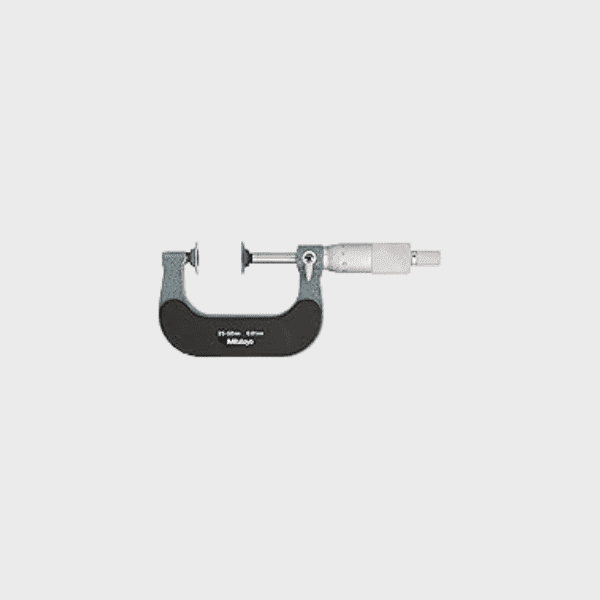Our Location
304 North Cardinal St.
Dorchester Center, MA 02124

Original price was: ₹10,500.00.₹9,600.00Current price is: ₹9,600.00.
| Specification | Details |
|---|---|
| Range | 0 – 25 mm |
| Graduation | 0.01 mm |
| Accuracy | ±4 µm (±0.004 mm) |
| Anvil Diameter | Ø20 mm |
| Measurable Gear Module | 0.5 – 6 |
The Mitutoyo 123-101 Disk Micrometer is a specialized variant of the traditional micrometer, designed specifically for measuring components like gear teeth, narrow grooves, and other hard-to-reach surfaces.
Featuring a disk-shaped anvil and spindle with flanges, this tool is engineered for applications requiring measurement over small gaps or uneven surfaces—tasks traditional micrometers can’t handle effectively.
The Mitutoyo 123-101 is a precision measuring tool engineered by one of the most reputable metrology brands in the world. Designed for measuring external dimensions, especially where conventional micrometers fall short, the 123-101 uses a unique disk-shaped measuring face that allows it to gauge gear tooth thickness, narrow slots, and other fine structural details.
What sets this model apart is the disk-shaped measuring faces, which allow users to measure gear teeth without interference from surrounding geometry. Unlike flat anvils on standard micrometers, the thin edges of the disks can easily slide into narrow slots or gear roots.
Additionally, the ratchet-stop mechanism ensures uniform pressure is applied during measurements, minimizing user-induced error. Combined with a vernier scale in metric units, the 123-101 offers an impressive level of accuracy down to 0.01 mm, suitable for high-precision applications in automotive, aerospace, and gear manufacturing industries.
While the underlying principle of measurement is the same—using a calibrated screw to determine the size of an object—the disk micrometer differs significantly in form and application from the standard micrometer.
| Feature | Disk Micrometer | Standard Micrometer |
|---|---|---|
| Measuring Faces | Disk-shaped | Flat anvil and spindle |
| Use Case | Gear teeth, grooves, narrow areas | General OD measurement |
| Surface Contact | Edge contact for fine areas | Full surface contact |
| Accuracy | ±4 µm | Typically ±2–3 µm |
| Application | Specialized, limited use | Broad, general use |
Disk micrometers are commonly used for:
The primary benefit of a disk micrometer is accessibility—its slender, disc-like anvils can reach places traditional micrometers cannot, without compromising measurement accuracy.
Each component of the 123-101 is designed with precision and durability in mind:
Crafted from hardened steel, the Ø20 mm disks provide edge contact for gear measurement. Flanged edges stabilize the tool, reducing wobble and enhancing measurement repeatability.
This feature ensures consistent measuring force, independent of user technique. Whether used by a novice or an experienced technician, the ratchet-stop prevents overtightening, protecting both the tool and the component being measured.
The scale allows readings to 0.01 mm resolution. The user reads the primary scale on the sleeve, followed by the rotating thimble to calculate the final measurement.
The robust C-frame is ergonomically designed and thermally stable, maintaining dimensional consistency even with fluctuating temperatures. A satin chrome finish reduces glare, making it easier to read under various lighting conditions.
A small lever near the thimble allows users to lock the spindle in place, useful for taking comparative measurements or recording sizes for QA documentation.
The Mitutoyo 123-101 is not your everyday micrometer. Its use is more specialized, making it invaluable in specific industrial scenarios.
The primary use case is gear inspection. The disk faces can fit between gear teeth, allowing for accurate measurement of the tooth thickness at the pitch line—a critical dimension that affects gear performance and noise.
In industries producing plastic films, paper rolls, or metal sheets, the disk micrometer is used to measure thickness without crimping or compressing the material, ensuring consistent product quality.
Machined components with slots, grooves, or delicate protrusions are common in aerospace and medical device manufacturing. The 123-101 ensures such features are within design tolerances.
Disk micrometers are used in checking gearbox components, differential gears, and timing gears, where accuracy is vital for performance and longevity.
Using the disk micrometer correctly ensures accurate readings and prolongs the tool’s life.
Routine calibration and care are essential for ensuring accuracy over the long term.
Neglecting calibration can lead to measurement drift, compromising your results and potentially leading to product recalls or rework.
While the 123-101 is a mechanical tool, digital and laser micrometers offer certain advantages and drawbacks.
| Feature | Disk Micrometer (123-101) | Digital Micrometer | Laser Micrometer |
|---|---|---|---|
| Power Source | None | Battery | External Power |
| Resolution | 0.01 mm | Up to 0.001 mm | 0.0001 mm or better |
| Portability | High | High | Low |
| Complexity | Low | Medium | High |
| Price | Moderate | High | Very High |
| Best Use | Gears, Grooves | General High-Precision | Non-contact, live inspection |
In many QA labs, multiple types are used together. The 123-101 is particularly advantageous in rugged environments where digital displays may be prone to damage or interference.
The Mitutoyo 123-101 Disk Micrometer exemplifies the precision, reliability, and specialized engineering needed in today’s high-tolerance manufacturing environments. With its unique disk-shaped anvils, ±4µm accuracy, and robust construction, it fills a critical niche—allowing professionals to measure gear teeth, narrow slots, and thin materials with ease and confidence. While it may not replace standard micrometers or digital tools for general use, it excels in situations where conventional instruments fall short.
By combining time-tested mechanical design with modern manufacturing standards, Mitutoyo delivers a tool that is both user-friendly and highly dependable. Proper use, regular calibration, and good maintenance practices will ensure the 123-101 remains a trustworthy companion in any metrology toolkit for years to come.
Reviews
There are no reviews yet.